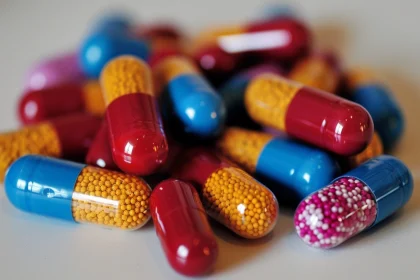We all know blood is red. But not all red blood is created equal. The exact shade of your blood can actually tell you a lot about what’s happening inside your body. And while you might not spend much time staring at your blood—unless you’re particularly accident-prone—knowing what healthy blood should look like could literally save your life.
The science behind blood’s color
Blood gets its color from hemoglobin, the protein in your red blood cells that carries oxygen throughout your body. When hemoglobin binds with oxygen, it turns bright red. When it drops off that oxygen to your tissues and organs, it turns darker.
This explains why blood coming from a cut looks bright red while the blood drawn during a blood test might look darker. It’s all about oxygen. That bright cherry red color means the blood is oxygen-rich, typically coming straight from your lungs through your arteries. The darker, more burgundy color means it’s traveling through your veins, heading back to your heart and lungs to pick up more oxygen.
Think of it like a delivery service. The bright red blood is like a truck full of packages ready for delivery. The darker blood is like that same truck after all the packages have been dropped off, heading back to the warehouse to reload.
When blood isn’t the right color
Most of us rarely see enough of our own blood to notice color variations. But healthcare professionals definitely pay attention, and there are times when you should too.
Blood that appears unusually dark, almost purple or blackish, can indicate severe oxygen deprivation. This is never normal and could signal a medical emergency like severe respiratory distress or cardiac problems.
On the flip side, blood that remains dark red even when it should be oxygen-rich might indicate problems with your hemoglobin. Conditions like carbon monoxide poisoning can change the way hemoglobin binds to oxygen, affecting your blood’s color and more importantly, its ability to deliver oxygen to your tissues.
Blood that has a brownish tint might indicate the presence of methemoglobin, a form of hemoglobin that can’t carry oxygen effectively. This can happen with certain medications or chemical exposures and requires medical attention.
Beyond red: when blood changes color
While healthy blood ranges from bright to dark red, there are rare situations where blood might appear different colors.
Blood can sometimes look orange or yellow in people with high levels of bilirubin, a yellowish substance produced when red blood cells break down. This might indicate liver problems or certain types of anemia.
In extremely rare cases, blood can look greenish. This weird phenomenon has been reported in sulfhemoglobinemia, a condition where sulfur gets incorporated into the hemoglobin molecule. It’s exceedingly uncommon but has been linked to certain medications.
Blue blood isn’t just for royalty. While it’s a myth that deoxygenated blood is blue inside your body, people with extremely pale skin might notice their veins appear blue through their skin. The blood inside is still red, but light scattering makes it look blue from outside.
Blood color and your health
Understanding what your blood should look like is more than just a biology lesson. It’s about recognizing potential warning signs.
If you notice brown blood during your period, it’s usually just older blood that took longer to leave your body. But consistently dark or abnormally colored menstrual blood could indicate endometriosis or other reproductive health issues.
Blood in your stool can range from bright red to black and tarry. The color provides important clues about where the bleeding is coming from. Bright red usually indicates bleeding in the lower gastrointestinal tract, while black stool typically means the blood has been digested and might come from higher up in your digestive system.
Blood in urine should never be ignored. Pink, red, or cola-colored urine can indicate anything from a simple UTI to kidney stones or more serious conditions.
When to worry about blood color
Any time you’re seeing blood when you shouldn’t, it’s worth having a conversation with your healthcare provider. But certain situations warrant immediate attention:
- Blood that’s abnormally dark or has a strange color like brown, orange, or green
- Black, tarry stool
- Dark, cola-colored urine
- Excessive bleeding from any source
- Blood in your vomit, which may appear like coffee grounds if partially digested
Conclusion
Your blood’s color tells a story about what’s happening inside your body. Normal, healthy blood ranges from bright scarlet to deep crimson, depending on its oxygen content. Anything outside that range might be your body sending up a warning flag.
Most of us will go through life without ever needing to worry about the color of our blood. But having this knowledge tucked away could help you recognize when something’s wrong. After all, your blood is literally your lifeline, carrying oxygen and nutrients to every cell in your body.
So while we hope you don’t have many occasions to see your own blood, knowing what it should look like is just another tool in your health awareness toolkit. Because when it comes to your health, sometimes color does matter.
















